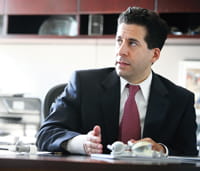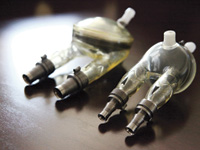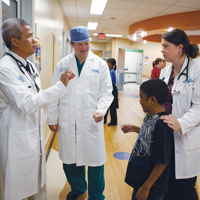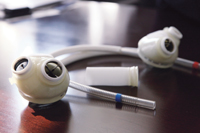When Hearts are Beyond Repair
For several decades, heart transplant has been the sole option for children whose hearts are damaged beyond repair. Success rates, particularly in the critical early months after heart transplant, have improved, largely due to advances in medical knowledge and therapies.
But long-term survival has proven more challenging, leaving transplant surgeons far from content with their progress so far, and continuing to search for better ways.
Clifford Chin, MD, is Medical Director of pediatric heart transplant services at Cincinnati Children’s. He attributes better survival rates in the crucial first year after transplant to advances in identifying kids at higher risk for rejection, even before the surgery takes place.
“We are using new technologies to detect potentially harmful antibodies in these children, and treating them aggressively while they are waiting for transplant,” Chin says. The treatment continues during the operation and throughout the post-transplant course, enabling children to overcome the initial rejection hurdles.
Longer-term survival remains a challenge, particularly because many children develop coronary artery disease in the transplanted heart. That, too, is leading to more careful monitoring and interventions to stave off problems. “We are now using a very sensitive technology, intravascular ultrasound, to detect and intervene on early disease,” Chin says. “And we are embarking on a number of research studies to enhance our knowledge of the rejection process with the aim of preventing disease.”
While doctors work to improve the odds, the facts remain that the number of children who need transplants is growing and transplantable hearts are in short supply.
Finding Alternatives
 |
Dr. David Morales believes mechanical assist devices are useful for far more than bridging the wait for a heart transplant. |
“We need something better,” says cardiovascular surgeon David Morales, MD. “Technology is going to be our answer.”
Morales, who joined Cincinnati Children’s in June 2012, is world-renowned for his work using mechanical assist devices in children. He implanted the first total artificial heart in a teenage boy in Texas two years ago. The young man, who subsequently had a heart transplant, is now a freshman in college.
Though the technology is still in its infancy, it is growing up fast, and it will be a game changer, Morales believes. As more companies race to develop smaller, better heart assist devices, doctors are finding innovative ways to use them to help children.
Bridging the Wait
Cincinnati Children’s transplant surgeon Alistair Phillips, MD, uses technology to buy children more time. As of June, Phillips had performed 12 heart transplants in less than a year, yet still had eight more children on the waiting list.
“The waiting time for hearts has increased in this region. Even status 1A patients wait on average two to four months,” he says.
 |
The Berlin EXCOR device is the only one currently approved by the FDA for use in children. |
Phillips uses the Berlin EXCOR device — the only one currently approved by the FDA for use in children — to keep weakened hearts beating until an organ becomes available for transplant.
 |
Drs. Clifford Chin and Alistair Phillips see better outcomes in heart transplant patients due to improved treatment before, during and after surgery. |
Mechanical devices can potentially do much more than bridge the wait time for a donor heart. Morales has already used them to get kids through temporary bouts of illness that impair heart function.
“For kids who have temporary causes of heart failure, such as myocarditis, we can put a device in temporarily, recover the heart, then take the device out,” he says.
Devices also offer options for children who have heart failure but are not candidates for transplant. Morales, Lynn Jefferies, MD, and an interdisciplinary team are assessing the potential for using assist devices in patients with Duchenne muscular dystrophy whose heart problems dominate their illness or who may improve overall with the use of the device.
“We will not cure their disease, but we will hopefully improve their quality of life,” Morales says.
Avoiding Transplant Altogether
He also wants to explore using assist devices to give a child’s weakened heart a chance to grow stronger — to such an extent that transplant might be unnecessary.
“By placing a device in someone who needs a transplant, can we recover the heart, then take out the device and the child will never need transplant?”
Morales’ question is more than rhetorical. He has already done this for one teenage boy, who is doing well a year and a half later. “He still takes medications, but he runs around, plays athletics, and has avoided transplant,” Morales says.
Although current devices are far from perfect, both surgeons envision a day when artificial devices put an end to heart transplant waiting lists.
“Ultimately there will be devices that will stay in place with internal battery systems and rechargeable battery systems,” says Phillips. “Technology is in its infancy now, but the miniaturization of these systems is coming. I always say, ‘Don’t bet against the engineers.’”
The Heart of the Matter
Much of the research at the Heart Institute at Cincinnati Children’s focuses on better understanding rejection after transplant, says transplant surgeon Alistair Phillips, MD.
 |
With more children needing transplants and fewer hearts available, companies are racing to develop better, smaller assist devices. |
Studies led by Lynn Jefferies, MD, Jeffrey Towbin, MD, and Clifford Chin, MD, are looking at how viral infections can affect transplant success.
“Some viruses actually cause the immune system to attack aspects of the vascular system,” says Phillips. “This can lead to chronic rejection and can accelerate coronary vasculopathies, which is the reason these hearts fail long-term.”
As a result of this research, the transplant team takes steps to build resistance to viral infection.
Several hours before transplant, patients receive intravenous immunoglobulin (IVIG). “The concept is that using this pooled blood product drawn from the community will help build antibodies to any viruses present at the time,” Phillips says.
Another measure used during surgery is plasmapheresis, which “washes” the patient’s blood of accumulated antibodies and lessens the likelihood of the immune system attacking the newly-placed heart.
Chin and his colleagues recently presented results with IVIG at the American Transplant Congress Scientific Sessions. “Using IVIG, we were able lower the pre-formed antibody burden in 13 patients,” he says, adding that all 13 patients survived their critical first year after transplant.



